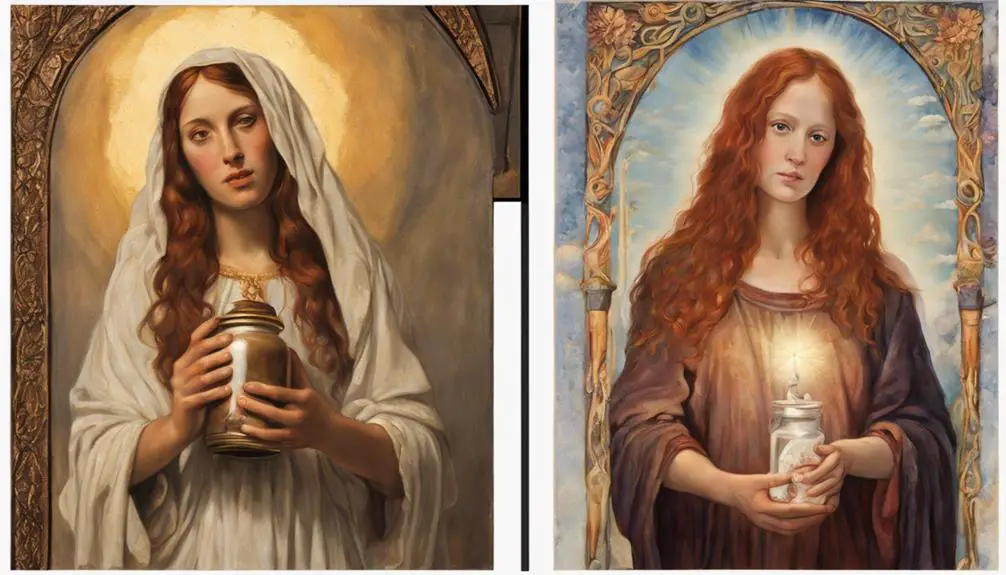Yielding secrets and symbolism, the Bible's redheads offer intriguing insights into divine narratives and human nature.

Redheads in the Bible
As you sift through the sands of time and scripture, you'll find that the Bible's landscape isn't just a tapestry of events and teachings but also a palette of diverse characters, including a surprising number of redheads. From Esau's hairy redness that symbolized his wild nature to the debated fiery locks of Mary Magdalene, these scarlet-tressed individuals aren't just footnotes but pivotal players with stories that resonate deeply in both religious and cultural contexts.
Their tales, shrouded in both mystery and enlightenment, invite you to explore further, beckoning you to uncover how their distinctive traits influenced their destinies and what that means for our understanding of biblical narratives.
Key Takeaways
- Red-haired biblical characters symbolize traits like passion, danger, and leadership.
- Cultural interpretations of red hair vary, with biblical stories influencing perceptions of power and treachery.
- Historical views of redheads as either blessed or cursed stem from their portrayal in the Bible.
- Biblical narratives have left a lasting impact on modern stereotypes and views of redheads.
The Legend of Esau

In the biblical narrative, Esau emerges as a pivotal figure, renowned for his distinctive red hair, which symbolizes his unique heritage and foreshadows the complex legacy he'd leave. This vivid characteristic isn't merely a physical attribute; it's imbued with deep symbolic significance, marking him as distinct within the annals of biblical figures. Esau's inheritance, central to his story, becomes a focal point of contention and a catalyst for the profound sibling rivalry that defines much of his life.
You'll find that Esau's narrative isn't just a tale of personal loss and betrayal but also an exploration of the familial and societal dynamics of his time. The loss of his birthright to Jacob, his younger twin, underlines the weight of expectations placed upon firstborn sons in ancient times. This pivotal moment, where Esau trades his inheritance for a momentary satisfaction, highlights the transient nature of material wealth against the backdrop of spiritual and familial duties.
Analyzing Esau's story, it's evident that his red hair serves as more than a mere marker of identity; it symbolizes the fiery character and tumultuous fate that would engulf his lineage. The sibling rivalry, sparked by the quest for Esau's inheritance, weaves a complex narrative of deceit, reconciliation, and ultimately, the diverging destinies of two nations.
King David's Fiery Crown

Moving beyond Esau's distinctive legacy, we now explore another biblical figure renowned for his remarkable red hair, King David, whose fiery crown symbolizes not only his royal authority but also his fervent spirit and dynamic leadership. David's heritage, as a shepherd boy anointed to be king, imbues his story with a sense of divine favor and destiny, which is further highlighted by his unique physical characteristic – his red hair. This trait sets him apart, visually manifesting his chosen status and foreshadowing his significant role in biblical history.
David's leadership qualities, exemplified by his courage in defeating Goliath, his wisdom in governing Israel, and his poetic prowess in composing Psalms, are often interpreted through the lens of his fiery crown. His red hair isn't merely a physical attribute but a symbol of the passion, strength, and resilience that define his kingship. Analyzing David's depiction in the Bible, it's clear that his red hair serves not just as an identifier but as a metaphor for his vibrant, spirited leadership and the burning zeal with which he pursued his divine mission.
Judas Iscariot's Controversial Hue

Shifting focus to New Testament narratives, Judas Iscariot's hair color, often depicted as red in various artistic and literary interpretations, introduces a complex layer to his portrayal as the betrayer of Jesus. This choice of hair color isn't arbitrary but loaded with cultural and historical significance, weaving a rich tapestry of meanings that both ancient and modern audiences can decipher.
Consider these points to deepen your understanding:
- Artistic interpretations often leverage hair color to symbolize character traits or fates. Red hair, associated with Judas, has historically been linked to treachery and otherness, setting him apart from the other disciples and foreshadowing his ultimate betrayal.
- The hair color significance in biblical times extends beyond mere fashion or personal preference. It speaks to the heart of Judas's narrative, offering a visual cue to his complex role within the Christian story. This color choice might reflect societal views on morality, identity, and destiny.
- Scholars argue that such symbolic use of hair color in storytelling serves not just to vilify Judas but also to engage with broader themes of trust, betrayal, and redemption.
Intriguingly, while the Bible itself doesn't specify Judas's hair color, these artistic choices contribute to a layered interpretation that enriches the biblical narrative.
Mary Magdalene: Fact Vs. Fiction

Disentangling the complex web of fact and fiction surrounding Mary Magdalene requires a careful examination of historical texts and cultural interpretations. You'll find that the narrative of Magdalene's ministry is often intertwined with historical inaccuracies that have shaped our understanding of her role in biblical history.
Fact |
Fiction |
|---|---|
Mary Magdalene was a close follower of Jesus and played a significant role in his ministry. |
Mary Magdalene was a prostitute before meeting Jesus. |
She is named in the Gospels more than most of the apostles, highlighting her importance. |
She is often confused with other women in the Bible, like Mary of Bethany or the unnamed sinner who anointed Jesus's feet. |
Mary Magdalene was present at the Crucifixion and was the first to witness the Resurrection. |
Her relationship with Jesus has been romantically embellished in popular culture and literature. |
Early Christian texts outside the canonical Gospels provide insights into her role as a leader in the early church. |
She is sometimes wrongfully depicted as having red hair, a detail not found in the Bible and irrelevant to her spiritual significance. |
Analyzing these contrasts helps clarify Magdalene's ministry and corrects historical inaccuracies, offering a more nuanced understanding of her biblical portrayal.
Symbolism of Red Hair in Scripture

In examining the symbolism of red hair in Scripture, it's crucial to understand the cultural and historical contexts that color its interpretations. The significance of hair, especially its color, often carries deep symbolic meanings, intertwined with the fabric of ancient societies. Red hair, specifically, stands out due to its rarity and the strong reactions it elicits.
Here are three key aspects to consider:
- Distinctiveness: Red hair in biblical times was rare, making individuals with such a feature stand out. This distinctiveness could symbolize uniqueness or otherness within a narrative, marking characters as either chosen by God or as outsiders.
- Cultural Associations: Different cultures surrounding biblical texts had varied interpretations of hair significance. Red hair's rarity might've been seen as divine or, conversely, ominous. Understanding these nuances is essential in grasping the full scope of color metaphors in Scripture.
- Symbolic Meanings: The symbolism of hair color often extends beyond mere physical appearance. Red, as a color, carries connotations of passion, danger, and power. Thus, characters with red hair in the Bible might embody these traits, whether in their divine calling or in their human flaws.
Analyzing these elements sheds light on the layered meanings behind red hair in Scripture, revealing the complexity of biblical color metaphors and their impact on character portrayal and narrative development.
Cultural Impact of Biblical Redheads

Having explored the symbolic significance of red hair in Scripture, we now focus on the cultural impact biblical redheads have exerted on subsequent generations and interpretations. The presence of red-haired figures in the Bible has not only enriched the narrative tapestry but also influenced historical perceptions and ginger stereotypes. This complex legacy is both fascinating and instructive.
Aspect |
Impact |
|---|---|
Art and Literature |
Redheads in biblical tales have inspired countless artworks and literary works, imbuing characters with traits often associated with red hair, such as passion and tenacity. |
Ginger Stereotypes |
Biblical narratives contributed to early stereotypes, both positive and negative, surrounding red-haired individuals. These perceptions have evolved but still echo in modern society. |
Historical Perceptions |
Historically, redheads were often seen as either blessed or cursed, a dichotomy that finds its roots in biblical stories. |
Religious Interpretations |
The depiction of biblical redheads has impacted religious and cultural interpretations, influencing how red hair is perceived in the context of moral and ethical qualities. |
This exploration reveals the deep and lasting impact biblical redheads have had on culture and perception, illustrating the power of religious narratives to shape societal views and stereotypes.
Frequently Asked Questions
How Does the Portrayal of Redheads in the Bible Compare to Their Depiction in Other Ancient Texts and Cultures?
When comparing the portrayal of redheads in ancient texts and cultures, you'll notice a unique blend of mythical symbolism and cultural significance.
Unlike other narratives, where red hair often signifies magical or otherworldly attributes, historical and mythological records differ vastly.
You'll find that these distinctions highlight diverse societal attitudes towards redheads, ranging from reverence to mistrust.
This analysis reveals how deeply hair color can influence perceptions of identity and character in various civilizations.
Are There Any Health-Related Myths or Superstitions About Redheads Mentioned or Hinted at in Biblical Texts?
You won't find explicit mentions of health-related myths or superstitions about redheads in biblical texts.
This absence reflects a broader historical context where red hair genetics and superstition origins diverge significantly from religious scripture.
Analyzing this, it becomes clear that while ancient texts and cultures might intertwine physical traits with mythical attributes, the Bible doesn't directly contribute to or endorse such superstitions, focusing instead on moral and spiritual teachings.
How Have Modern Interpretations and Translations of the Bible Influenced the Perception of Biblical Characters Thought to Have Red Hair?
Investigating how modern translations and interpretations of the Bible affect perceptions of characters, you'll find translation challenges and cultural biases at play. These elements significantly influence how characters, possibly thought to have red hair, are viewed today.
Scholars face hurdles in accurately conveying ancient texts' meanings, compounded by biases stemming from contemporary cultural contexts. This scholarly analysis reveals the complex interplay between historical texts and modern perceptions, reshaping our understanding of biblical figures.
Aside From the Individuals Mentioned, Are There Lesser-Known Biblical Figures Purported to Have Red Hair, Based on Historical or Scholarly Interpretations?
You're diving into a niche topic, exploring lesser-known figures who might've had red hair, based on historical or scholarly interpretations. Artistic representations and genetic speculation fuel this curiosity, offering a unique lens through which to view these individuals.
Analyzing texts and examining artifacts, you're not just reading between the lines—you're piecing together a colorful tapestry of the past, where even hair color can shed light on a person's identity and story.
In What Way Does the Bible Address or Ignore the Genetic Rarity and Regional Distribution of Red Hair Among Ancient Populations?
You're diving into how ancient texts, like the Bible, might skirt around the nuances of red hair's genetic rarity and its spread across different regions. The Bible doesn't delve into genetic studies or address hair dyeing practices directly, leaving a gap in understanding.
Your curiosity peels back layers of historical interpretation, seeking where science and scripture intersect, or don't. This analytical journey questions the depth of biblical acknowledgment toward such specific human traits.
Conclusion
In your journey through the tapestry of biblical narratives, you've traversed the vibrant threads of redheads, from Esau's rugged terrain to the enigmatic shades of Mary Magdalene. These crimson strands weave a complex pattern, illuminating the intricate interplay between divinity and humanity, heritage, and destiny.
Like a phoenix rising from the ashes, the symbolism of red hair in scripture burns with questions of identity, morality, and transcendence, challenging us to look beyond the surface and contemplate the deeper hues of our own beliefs.



Sign up